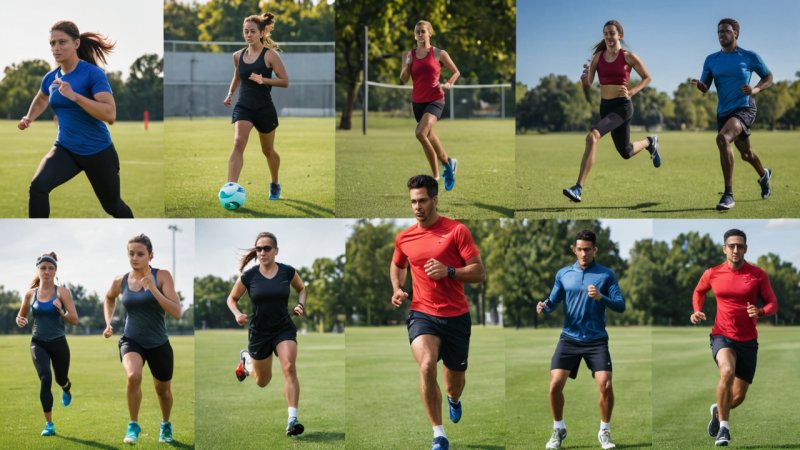As athletes prepare for the seasonal changes in their sports, a well-structured training plan becomes paramount. Whether you're gearing up for football in the fall, skiing in the winter, cycling in the spring, or engaging in outdoor activities during the summer, a training plan not only enhances performance but also prioritizes safety. Crafting a comprehensive training strategy helps athletes stay on track, avoid injuries, and reach peak performance while adapting to the unique demands of each sport. In this article, we’ll delve into essential elements of an effective training plan, specific to seasonal sports, and how to incorporate safety equipment and technology to improve overall athletic performance.
Understanding the Seasonal Demands
Each sport has its own set of demands that vary with the seasons. For instance, winter sports such as skiing and snowboarding require not just physical strength but also agility and balance on snow-covered terrains. In contrast, summer sports like cycling and outdoor running focus on endurance and stamina in warmer conditions. Understanding these seasonal demands is the first step in creating a tailored training plan. Consider the following:
- Physical Requirements: Identify the key physical attributes required for your sport, such as strength, speed, agility, and endurance.
- Weather Conditions: Factor in how seasonal weather will impact training—heat, cold, and precipitation can all influence your training strategy.
- Competition Schedule: Align your training cycles with the competition schedule to peak at the right times.
Setting Achievable Goals
Once you understand the seasonal demands, the next step is to set clear and achievable goals. Goals provide direction and motivation, and they should be SMART—Specific, Measurable, Achievable, Relevant, and Time-bound. Here’s how to apply the SMART criteria:
- Specific: Instead of saying, "I want to get better at cycling," specify, "I want to improve my cycling speed by 2 mph by the end of the season."
- Measurable: Track progress through metrics like lap times, distances, or endurance tests.
- Achievable: Set goals that challenge you but are still within reach based on your current fitness level.
- Relevant: Ensure your goals align with your overall aspirations in your sport.
- Time-bound: Set deadlines for achieving your goals to maintain focus and accountability.
Incorporating Safety Equipment
Safety should always be a priority in any training plan. Depending on the sport, various protective gear may be necessary to reduce the risk of injuries. For example, football players should wear helmets and pads, while cyclists need helmets and reflective gear for visibility. Here are a few tips on incorporating safety equipment into your training:
- Choose Appropriate Gear: Select equipment that meets safety standards specific to your sport and ensure it fits properly.
- Regular Maintenance: Inspect and maintain your safety gear regularly to ensure it functions as intended.
- Educate Yourself: Stay informed about the latest safety advancements and recommendations in protective gear.
Utilizing Athletic Technology
The landscape of athletic training has evolved significantly with advancements in technology. From wearable fitness trackers to apps that analyze performance, incorporating technology can enhance your training plan. Consider the following:
- Wearable Devices: Devices like smartwatches and heart rate monitors can help track your workouts, monitor your heart rate, and provide insights into your performance.
- Training Apps: Use apps that provide workout plans, instructional videos, and progress tracking capabilities.
- Virtual Reality Training: For some sports, virtual reality can simulate competitive scenarios, allowing athletes to practice their skills in a safe environment.
Designing Your Training Schedule
With goals set and safety measures in place, it's time to design your training schedule. A well-structured training plan typically includes:
- Warm-Up and Cool-Down: Always start with a proper warm-up to prepare your body and end with a cool-down to aid recovery.
- Skill Development: Allocate time for drills and skill-building exercises specific to your sport.
- Endurance Training: Integrate longer sessions focusing on stamina and cardiovascular fitness.
- Strength Training: Implement exercises to build muscle strength, focusing on core stability and sport-specific muscle groups.
- Rest Days: Schedule regular rest days to allow your body to recover and prevent burnout.
Monitoring Progress and Making Adjustments
Finally, as you implement your training plan, it's crucial to monitor your progress. Regularly assess whether you are meeting your goals and how your body is responding to the training. Here are a few tips for effective monitoring:
- Keep a Training Log: Document workouts, performance metrics, and how you feel after each session.
- Adjust as Needed: Be flexible in your training plan; if something isn't working, don't hesitate to modify your approach.
- Seek Feedback: Consider working with a coach or trainer who can provide professional insights and adjustments to your training.
In conclusion, creating an effective training plan for seasonal sports involves understanding the unique demands of each sport, setting achievable goals, incorporating safety equipment, leveraging athletic technology, designing a comprehensive schedule, and continuously monitoring progress. By prioritizing safety and adapting your training to the seasonal context, you can not only enhance your performance but also enjoy your sport to the fullest while minimizing the risk of injuries.






